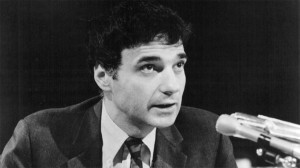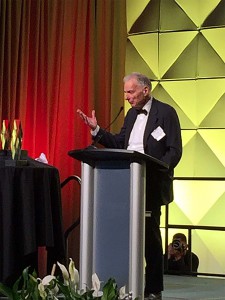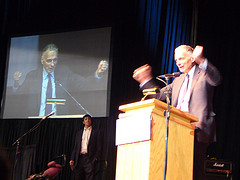The man once accused of trying to destroy Detroit now has a permanent home in the Motor City.
Ralph Nader, the consumer advocate credited with changing the way the auto industry operates with his critical book, “Unsafe at Any Speed,” was one of four industry legends inducted into the Automotive Hall of Fame on Thursday night, joining retired Ford CEO Alan Mulally, automotive engineer Roy Lunn and Bertha Benz, the wife and financier of pioneer Karl Benz.
“There are thousands of people who would be dead if it weren’t for Ralph Nader,” said publisher Keith Crain as he introduced the 82-year-old Nader to an audience of industry managers and executives gathered for the black tie affair.
Coming onto the stage, the one-time independent presidential candidate made it clear that age has not mellowed him. Nader’s speech raised serious concerns about a new era of automobiles that have become “supercomputers on wheels.”
Trained as a lawyer, a graduate of Princeton and Harvard, the son of Lebanese immigrants also filled in some of the blanks, explaining why he became such a strong advocate for automotive safety. “I lost a lot of friends in high school” to car crashes, Nader said, adding that while in college he frequently hitchhiked around the country and often saw the “mayhem” caused by crashes that could have been prevented by safer vehicle designs.

Ralph Nader testifies before Congress in 1966. It was 50 years ago that his groundbreaking book, "Unsafe at Any Speed," was published.
He began writing about automotive safety while still in school, but it was the 1965 publication of “Unsafe at Any Speed” that brought him to the attention of the public – and to General Motors. While a broad treatise on vehicle safety, it focused on the then wildly popular Chevrolet Corvair’s frequent involvement in one-car accidents.
(50 years later, are cars still “Unsafe at Any Speed”? Click Here for more.)
GM’s response was to hire private detectives who followed Nader, tapped his phone and even hired prostitutes to entrap him in unflattering situations. Nader sued and eventually won a settlement he used to set up the non-profit Center for the Study of Responsive Law. But the scandal had a bigger impact.
In a video celebrating the consumer advocate, former National Highway Traffic Safety Administration chief Joan Claybrook noted that in the wake of the GM revelations, Washington lawmakers rushed to approve the nation’s first comprehensive auto safety legislation.
“Some of the arguments against greater safety bordered on hilarious tragedy,” Nader said in his speech, telling the Automotive Hall of Fame audience how he would frequently fly into Detroit and meet industry engineers in cabs that would circle the airport while they would reveal problems that they couldn’t get fixed.
“Unleash the engineers and you won’t believe what can happen,” Nader declared in his speech, or “how fast it can happen.”
He pointedly stressed that since the passing of those original safety standards the highway fatality rate in the U.S. has fallen five-fold, saving an estimated 3 million American lives.
(Automakers can’t sacrifice safety in rush for autonomous vehicles, Transportation chief warns. Click Here for the latest.)
Explaining his early years, when many questioned why an Ivy League-trained lawyer would focus on auto safety, Nader recalled when Time magazine put him on its cover. The reporter called his mother and repeatedly asked her what makes Ralph tick. “What makes you not tick?” she said to him.
Nader took several runs at politics, most famously in 2000, as an independent candidate for president. He ultimately received about 2.9 million votes, or 2.74% of those cast nationwide. Some critics say that cost Al Gore the White House, tipping Florida in favor of Republican George Bush. It is a claim many, including Nader, deny.
(Automakers, regulators pair up in “historic” shift on safety. Click Here for the story.)
The Thursday evening ceremony saw Nader inducted into the Hall of Fame alongside three more traditional industry honorees:
- Alan Mulally, the long-time Boeing executive who agreed to take on the job of CEO of Ford Motor Company in 2006, just as the maker was set to report its biggest loss ever and was considered a candidate for bankruptcy. In fact, Ford was able to sidestep Chapter 11 even as cross-town rivals General Motors and Chrysler had to turn to the federal government for bailouts to survive;
- Roy Lunn, one of Detroit’s most celebrated engineers. He turned Ford into a serious contender in global endurance racing as the engineer of the GT40 race car that dominated the circuit in Europe in the mid to late-1960s. But he worked on a number of other influential projects for Ford and, later American Motors. At 91, Lunn continues to write and work on automotive projects from his home in California;
- Bertha Benz. The wife of Karl Benz, credited with inventing the automobile, Bertha played a critical role in the Benz Patent-Motorwagen’s development and promotion and provided the cash needed for her husband to start his manufacturing business. She famously took the first long drive in his car, at one point fixing a balky carburetor with a hat pin and re-insulating a shorted wire using a garter.




The first rule of ANY Hall of Fame induction: no troublemakers allowed. Nader is a troublemaker.
Perhaps, but he is a useful troublemaker. He broke a dangerous paradigm, an industry that had convinced itself that “safety doesn’t sell.” And, in the process, he has likely been responsible for saving more lives on the highway than anyone. His speech might have been a bit unpleasant for some in the AHF ceremony’s induction, but it was a message they needed to be reminded of. And so do the folks who will now see Nader alongside some of those very same executives, already enshrined in the Hall, who would have blithely continued building cars that were unsafe at any speed.
Paul E.